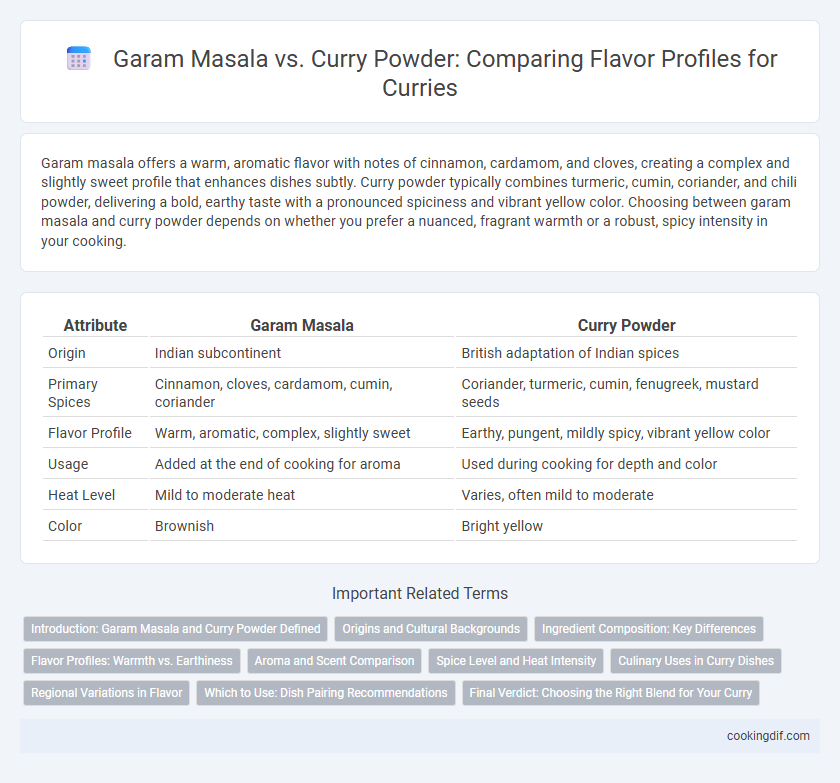Garam masala offers a warm, aromatic flavor with notes of cinnamon, cardamom, and cloves, creating a complex and slightly sweet profile that enhances dishes subtly. Curry powder typically combines turmeric, cumin, coriander, and chili powder, delivering a bold, earthy taste with a pronounced spiciness and vibrant yellow color. Choosing between garam masala and curry powder depends on whether you prefer a nuanced, fragrant warmth or a robust, spicy intensity in your cooking.
Table of Comparison
| Attribute | Garam Masala | Curry Powder |
|---|---|---|
| Origin | Indian subcontinent | British adaptation of Indian spices |
| Primary Spices | Cinnamon, cloves, cardamom, cumin, coriander | Coriander, turmeric, cumin, fenugreek, mustard seeds |
| Flavor Profile | Warm, aromatic, complex, slightly sweet | Earthy, pungent, mildly spicy, vibrant yellow color |
| Usage | Added at the end of cooking for aroma | Used during cooking for depth and color |
| Heat Level | Mild to moderate heat | Varies, often mild to moderate |
| Color | Brownish | Bright yellow |
Introduction: Garam Masala and Curry Powder Defined
Garam masala is a blend of warm, aromatic spices including cinnamon, cloves, cardamom, and cumin, creating a rich and intense flavor primarily used in Indian cuisine. Curry powder, originally a British interpretation, combines turmeric, coriander, cumin, and fenugreek, offering a milder, earthier taste with bright golden color. Understanding the distinct spice compositions highlights their unique roles in flavoring dishes and cultural culinary traditions.
Origins and Cultural Backgrounds
Garam Masala originates from northern India and features a complex blend of warm spices such as cinnamon, cloves, and cardamom, creating a rich, aromatic flavor profile often used in slow-cooked dishes. Curry powder, developed by the British during colonial times, is a more standardized mixture typically including turmeric, cumin, and coriander, designed to replicate the diverse tastes of Indian cuisine in a convenient form. The cultural background of Garam Masala is deeply rooted in traditional Indian cooking techniques, while curry powder reflects a colonial adaptation aimed at Western palates.
Ingredient Composition: Key Differences
Garam masala typically consists of ground spices such as cinnamon, cloves, cardamom, cumin, and black pepper, creating a warm, aromatic, and complex flavor profile. Curry powder, on the other hand, usually combines turmeric, coriander, cumin, fenugreek, and chili powder, offering a more pungent, earthy, and robust taste. The key difference lies in garam masala being a blend of warming spices often added at the end of cooking, while curry powder incorporates turmeric and is commonly used as a base spice mix in various curry dishes.
Flavor Profiles: Warmth vs. Earthiness
Garam masala delivers a complex warmth with aromatic spices like cinnamon, cloves, and cardamom creating a sweet and spicy depth. Curry powder emphasizes earthiness through turmeric, cumin, and coriander, providing a robust and slightly bitter base. The choice between garam masala and curry powder defines whether a dish highlights warming spice layers or grounded, earthy undertones.
Aroma and Scent Comparison
Garam Masala offers a warm, robust aroma with prominent notes of cinnamon, cloves, and cardamom, creating a sweet and spicy scent that is deeply aromatic. Curry powder features a more complex fragrance blend dominated by turmeric, coriander, and cumin, giving it an earthy, slightly pungent scent with subtle citrus undertones. The distinct aromatic profiles of garam masala and curry powder significantly influence the overall flavor experience, with garam masala providing a richer, more intense fragrance compared to the lighter, zestier aroma of curry powder.
Spice Level and Heat Intensity
Garam Masala offers a warm, aromatic spice blend with moderate heat intensity, emphasizing spices like cinnamon, cloves, and cardamom that provide depth without overwhelming spiciness. Curry powder typically delivers a more robust and pungent flavor with a higher spice level, featuring turmeric, cumin, coriander, and chili powder to bring bold heat and vibrant color. Choosing between garam masala and curry powder influences the dish's overall heat, where garam masala imparts subtle warmth and curry powder contributes stronger, sharper heat profiles.
Culinary Uses in Curry Dishes
Garam masala and curry powder offer distinct flavor profiles that shape the taste of curry dishes uniquely. Garam masala, a blend of warm spices like cinnamon, cloves, and cardamom, lends a rich, aromatic warmth ideal for finishing curries or enhancing slow-cooked stews. Curry powder, typically a mix of turmeric, coriander, cumin, and fenugreek, provides a vibrant, earthy base flavor suited for marinades, sauteing vegetables, and creating a bold curry sauce.
Regional Variations in Flavor
Garam masala and curry powder differ significantly in their regional flavor profiles, with garam masala rooted in North Indian cuisine featuring warm spices like cinnamon, cardamom, and cloves that create a rich, aromatic depth. Curry powder, a British-invented blend inspired by Indian cuisine, often includes turmeric, coriander, and cumin, yielding a milder, earthier taste tailored to Western palates. These regional variations in spice combinations reflect local ingredient availability and cultural preferences, making garam masala more robust and curry powder more versatile in global dishes.
Which to Use: Dish Pairing Recommendations
Garam Masala offers a warm, aromatic flavor with notes of cinnamon, cloves, and cardamom, making it ideal for hearty dishes like lamb rogan josh or butter chicken. Curry powder provides a more complex, often turmeric-forward taste suitable for vegetable curries, soups, and stews requiring a vibrant, earthy profile. Use garam masala as a finishing spice to enhance richness, while curry powder works well during cooking to build layered flavors.
Final Verdict: Choosing the Right Blend for Your Curry
Garam masala delivers a warm, complex flavor with aromatic spices like cinnamon, cloves, and cardamom, ideal for adding depth at the end of cooking. Curry powder combines turmeric, coriander, cumin, and fenugreek, providing a bright, earthy taste suited for early-stage cooking and building layers of flavor. Selecting the right blend depends on desired intensity and cooking stage, with garam masala best for finishing rich dishes, while curry powder excels in creating foundational spice profiles.
Garam Masala vs Curry Powder for flavor profile Infographic

 cookingdif.com
cookingdif.com